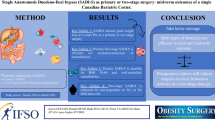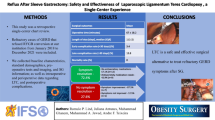Abstract
Background
Laparoscopic Roux-en-Y gastric bypass (RYGB) is an effective treatment modality for severe obesity. Failure of weight loss and/or weight regain due to lack of restriction has been reported in long-term follow-up studies. The aim of this study is to determine the safety and effectiveness of reestablishing the restrictive component of the operation by trimming the pouch and/or anastomosis for pouch and/or anastomotic enlargement using a laparoscopic approach.
Methods
We retrospectively reviewed our prospectively collected database for all patients that underwent revisional surgery of RYGB for weight regain or failure of weight loss. Percent excess weight loss (%EWL) and BMI loss (BMIL) were characterized into the following three time periods: (1) primary operation to pre-revision, (2) pre-revision to post-revision, and (3) primary operation to post-revision. Post-operative follow-up was at 6, 12, 18, 24, 36, and 48 months.
Results
Between 2005 and 2011, a total of 121 patients in the database underwent revision of RYGB. Forty-four patients were identified that fulfilled the aforementioned parameters. In this group, 30 patients underwent trimming of the pouch and/or redo anastomosis (TPA), 8 TPA and conversion from retrocolic to antecolic Roux limb, and 6 TPA with remnant gastrectomy. Mean follow-up period was 26.1 ± 22.7 months. The post-revision mean %EWL was 38 %, and the BMI loss was 7 kg/m2. In the pre-revision to 48 months post-revision time period, mean %EWL and BMIL were 28.6 % and 4.9 kg/m2 in the TPA-only group, 52 % and 8.8 kg/m2 in the TPA with conversion to antecolic, antegastric group, and 33.4 % and 5.9 kg/m2 in the TPA with gastrectomy group, respectively (%EWL, p = 0.096; BMIL, p = 0.227). One patient (2.3 %) developed a left upper quadrant hematoma. There was no mortality in this series.
Conclusions
Trimming of the pouch and/or anastomosis appears to be a safe and effective revisional modality for patients with insufficient weight loss or weight regain after gastric bypass in the hands of experienced surgeons.


Similar content being viewed by others
References
Buchwald H, for the Consensus Panel. Consensus conference statement: bariatric surgery for morbid obesity: health implications for patients, health professionals, and third-party payers. Surg Obes Relat Dis. 2005;1(3):371–81.
Parikh M, Pomp A, Gagner M. Laparoscopic conversion of failed gastric bypass to duodenal switch: technical considerations and preliminary outcomes. Surg Obes Relat Dis. 2007;3(6):611–8.
Brolin RE, Cody RP. Adding malabsorption for weight loss failure after gastric bypass. Surg Endosc. 2007;21(11):1924–6.
Yimcharoen P, Heneghan H, Singh M, et al. Endoscopic findings and outcomes of revisional procedures for patients with weight recidivism after gastric bypass. Surg Endosc. 2011;25(10):3345–52.
Herron DM, Birkett DH, Thompson CC, et al. Gastric bypass pouch and stoma reduction using a transoral endoscopic anchor placement system: a feasibility study. Surg Endosc. 2008;22(4):1093–9.
Muller MK, Wildi S, Scholz T, et al. Laparoscopic pouch resizing and redo of gastrojejunal anastomosis for pouch dilatation following gastric bypass. Obes Surg. 2005;15(8):1089–95.
Chin PL, Ali M, Francis K, et al. Adjustable gastric band placed around gastric bypass pouch as revision operation for failed gastric bypass. Surg Obes Relat Dis. 2009;5(1):38–42.
Rawlins ML, Hedgcorth K, Maguire JP. Revision of Roux-en-Y gastric bypass to distal bypass for failed weight loss. Surg Obes Relat Dis. 2011;7(1):45–9.
Patel S, Szomstein S, Rosenthal RJ. Reasons and outcomes of reoperative bariatric surgery for failed and complicated procedures (excluding adjustable gastric banding). Obes Surg. 2011;21(8):1209–19.
Marks VA, Cruz-Munoz N. Three techniques to laparoscopically improve restriction after failed gastric bypass: revision of failed LRYGBP restriction. Surg Obes Relat Dis. 2011;7(5):659–60.
Ellesmere JC, Thompson CC, Brugge WR, et al. Endoscopic interventions for weight loss surgery. Obes Silver Spring. 2009;17(5):929–33.
Reinhold RB. Critical analysis of long term weight loss following gastric bypass. Surg Gynecol Obstet. 1982;155(3):385–94.
Heneghan HM, Yimcharoen P, Brethauer SA, et al. Influence of pouch and stoma size on weight loss after gastric bypass. Surg Obes Relat Dis. 2012;8(4):408–15.
Roberts K, Duffy A, Kaufman J, et al. Size matters: gastric pouch size correlates with weight loss after laparoscopic Roux-en-Y gastric bypass. Surg Endosc. 2007;21(8):1397–402.
Bessler M, Daud A, DiGiorgi M, et al. Adjustable gastric banding as revisional bariatric procedure after failed gastric bypass—intermediate results. Surg Obes Relat Dis. 2010;6(1):31–5.
Horgan S, Jacobsen G, Weiss D, et al. Incisionless revision of post-Roux-en-Y bypass stomal and pouch dilation: multicenter registry results. Surg Obes Relat Dis. 2010;6(3):290–5.
Sultan BA, Parikh M, Youn H, et al. How much EWL is enough? A Bayesian analysis to determine minimal EWL to deliver improvement/resolution of comorbidities after laparoscopic adjustable gastric banding in patients with BMI 30-40. Presented at 25th annual meeting of the American Society for Metabolic and Bariatric Surgery. Washington, D.C. June 15-20, 2008. Presentation No. PL-17.
Tian HL, Tian JH, Yang KH, et al. The effects of laparoscopic vs. open gastric bypass for morbid obesity: a systematic review and meta-analysis of randomized controlled trials. Obes Rev. 2011;12(4):254–60.
Martin MJ, Mullenix PS, Steele SR, et al. A case-match analysis of failed prior bariatric procedures converted to resectional gastric bypass. Am J Surg. 2004;187(5):666–70. discussion 670-1.
Zingg U, McQuinn A, DiValentino D, et al. Revisional vs. primary Roux-en-Y gastric bypass—a case-matched analysis: less weight loss in revisions. Obes Surg. 2010;20(12):1627–32.
Baker RS, Foote J, Kemmeter P, et al. The science of stapling and leaks. Obes Surg. 2004;14(10):1290–8.
Conflict of Interest
The authors Raul Rosenthal, David Nguyen, Fernando Dip, Jorge Huaco, Emanuele LoMenzo, Samuel Szomstein, Hira Ahmad, and Rena Moon have no conflicts of interest.
Statement of Informed Consent
Does not apply.
Statement of Human and Animal Rights
For this type of study, formal consent is not required.
Author information
Authors and Affiliations
Corresponding author
Rights and permissions
About this article
Cite this article
Nguyen, D., Dip, F., Huaco, J.A. et al. Outcomes of Revisional Treatment Modalities in Non-Complicated Roux-En-Y Gastric Bypass Patients with Weight Regain. OBES SURG 25, 928–934 (2015). https://doi.org/10.1007/s11695-015-1615-9
Published:
Issue Date:
DOI: https://doi.org/10.1007/s11695-015-1615-9




